Mark McGill of Abel New Zealand wrote in an email: “Great article, however you forgot to include any information regarding leaf removal by sheep which is a very common practice here in New Zealand and provides an alternative between man and machine!”
I was fully aware of the benefits of using sheep in vineyards for weed control, mowing and soil health, but hadn’t thought they could be used for leaf-stripping.
Most of the vineyards I’ve visited only overwinter their woolly workers – moving them on as soon as any green shoots appear. But Mark, who specialises in Chardonnay and cider at his 30ha farm in Tasman, at the top of New Zealand’s South Island, says he uses them for leaf removal, too.
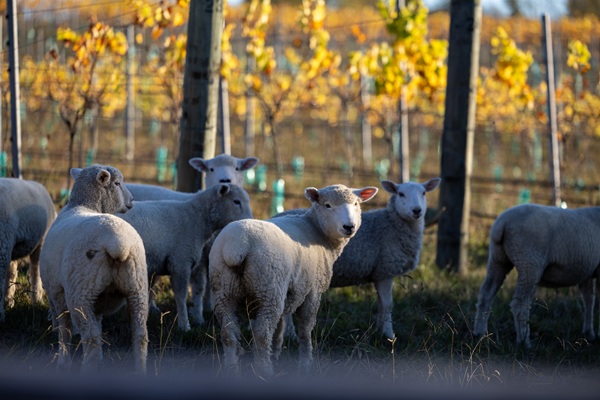
He says: “They’re the best leaf-plucking machines going around as they also do your weeding, bud-rubbing, composting and fertilising while they’re at it. Highly autonomous too!”
As for the number and changes to the training system, he advises: “A good starting guide is 200 sheep per hectare for 24-48 hours. Here, we do less sheep per hectare for a good week, but we also have plenty of feed on the ground too. Otherwise, they’ll strip the canopy as high as they can reach or climb!
“Our fruiting wire is at 1,200mm. We moved it up after starting out like most at 900mm.”
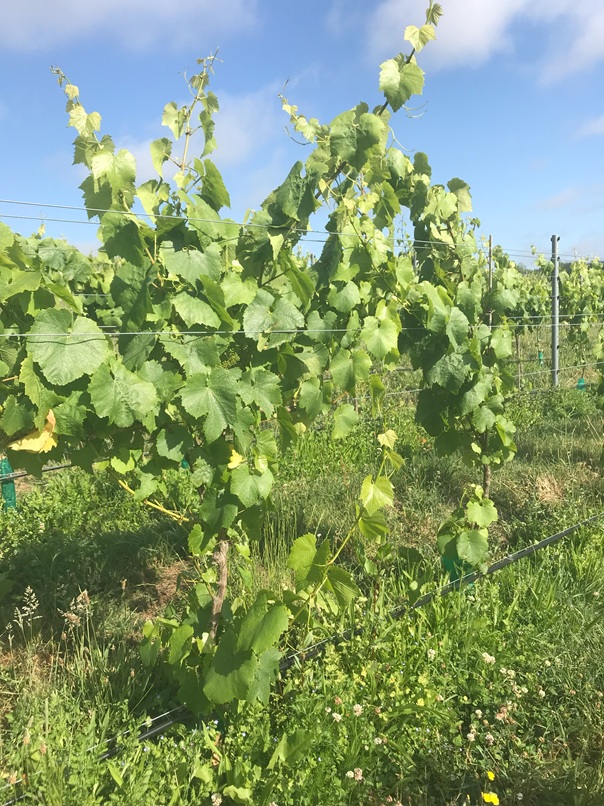
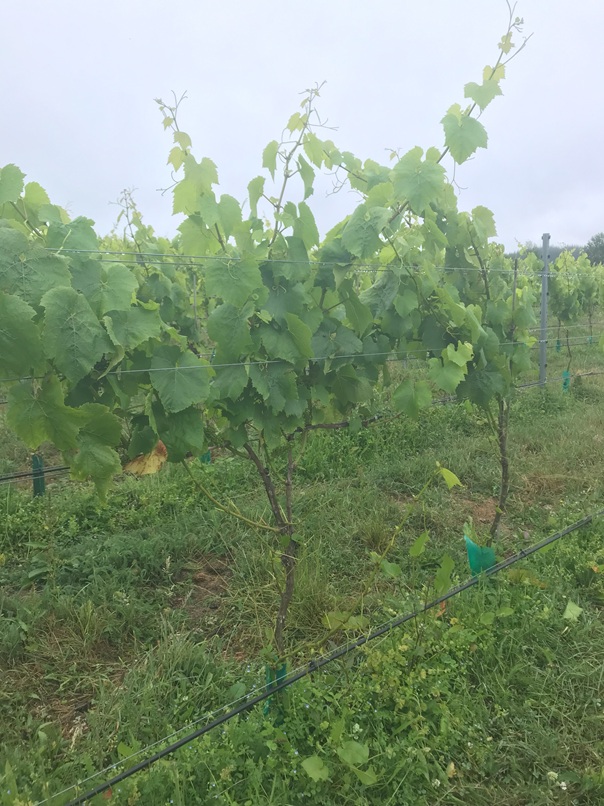
Photos shows ‘before’ and ‘after’ on a young Chardonnay vine.
Here is Canopy’s guide to using sheep in vineyards
What jobs can sheep do in a vineyard?Job: Floor-maintenance and weed control
How the flock helps: Sheep graze undervine vegetation and mow tractor alleys, replacing herbicides or repeated slashing
Timing: Dormant season everywhere; year-round if trellis is >1.4 m
Job: Targeted leaf removal (“leaf-plucking”)
How the flock helps: Short breeds strip basal leaves for better light exposure and disease control
Timing: 80% flowering → pea-size berries
Job: Sucker and water-shoot removal
How the flock helps: Browsing on trunks eliminates hand suckering
Timing: Spring
Job: Cover-crop termination and fertilisation
How the flock helps: Animals convert cover biomass to manure, returning N, P and K
Timing: Late winter/early spring
Job: Soil health services
How the flock helps: Hoof action lightly tills surface, stimulates microbiology and builds carbon
Timing: Whenever they’re in-block
Job: Eco-engineering
How the flock helps: Reduces tractor passes, diesel, compaction and noise; entertains visitors
Timing: All season
How efficient are they?
Labour and fuel: In a California silvopasture trial, integrating sheep eliminated 4-8 tractor passes per row per year, and saved 20hr of labour an acre on suckering and mowing, while turning that biomass into fertility.
Leaf-plucking rate: Hawke’s Bay (NZ) growers report 100-300 mature ewes clearing 1-3ha in 48-72hr; Greystone (NZ) achieves 90-95% fruit-zone exposure by running ~200 ewes/ha for 24-36hr.
Carbon and GHG footprint: Two-year California fieldwork found no net increase in cumulative N₂O, CH₄ or CO₂ and showed comparable yields to ungrazed controls. Longer-term surveys across four California estates recorded higher microbial biomass-C and deeper (30-45cm) mineral-associated SOC with no rise in bulk-density.
Water and irrigation: In the same silvopasture trial, irrigation demand fell by ~90% relative to a conventional neighbour, attributed to permanent groundcover and fewer tractor passes compacting soil.
Economic signals from growers: Interviews with 33 California vineyard managers showed universal satisfaction with labour and fuel savings; non-adopters mainly cited fencing or spray‐residue logistics rather than efficacy.
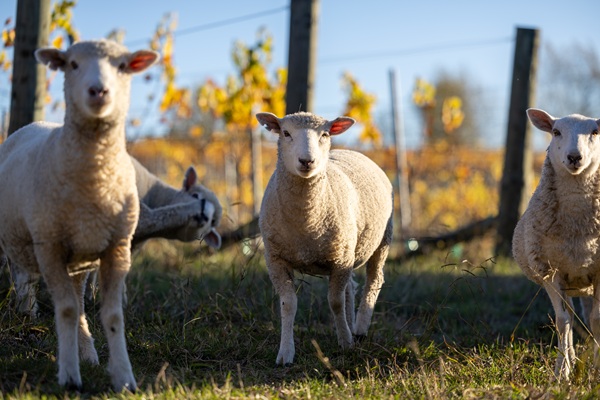
Which breeds work best?
Breed: Babydoll Southdown
Height/behaviour: 45-60cm at shoulder; can’t reach fruit on standard cordons
Sweet spot in the vineyard: Ideal for leaf-plucking under VSP and low wire; widely used in NZ and CA
Breed: Shropshire (“Danish-type”)
Height/behaviour: Stockier, instinctively stays on all fours; avoids bark chewing
Sweet spot in the vineyard: Suits European Guyot systems during growth as well as dormancy
Breed: Ouessant (Breton Dwarf)
Height/behaviour: Very small (13-16kg) so safe but low grazing throughput
Sweet spot in the vineyard: Handy for hobby blocks or mixed orchards where canopy is very low. Biodynamic producer Château Palmer in Bordeaux uses them
Breed: Romney and Wiltshire Horn
Height/behaviour: Medium height, robust in damp cool climates
Sweet spot in the vineyard: Winter grazing in UK (eg. Nyetimber) and Pacific NW
Breed: Dorper/Katahdin (hair sheep)
Height/behaviour: Heat-tolerant, no shearing; heavier browsing reach
Sweet spot in the vineyard: Wide-alley, high-cordon sites in Mediterranean and Paso Robles (eg. Tablas Creek)
Key breeding insight: A German study of 26 breeds concluded that the single most useful trait is the “inability to stand on two legs”; Shropshire and Southdown excelled here, avoiding fruit stripping even during véraison.
Key benefits
Agro-ecological gains: Higher biodiversity, nutrient cycling and surface cover translate into better infiltration and reduced erosion.
Fewer chemicals: Growers replacing herbicides and undervine cultivation report 1-2 spray passes dropped per season and lower exposure risk for staff.
Marketing and tourism: Flocks create ‘Instagram moments’, dovetail with organic, biodynamic and Regenerative Organic certifications.
So, what’s the catch?
Risk: Vine or fruit damage if sheep stay too long or get thirsty
Mitigation: Tight block-size grazing (1-3ha), ample troughs, daily checks
Risk: Soil compaction on heavy ground in wet winters
Mitigation: Use lower stocking density or move flocks onto headlands after rain
Risk: Chemical residues and withholding periods
Mitigation: Align spray calendar with grazing windows; some systemic fungicides need a 30- to 90-day interval
Risk: Fencing and predator control cost
Mitigation: Mobile electric fencing
Risk: Salt build-up in arid sites
Mitigation: Monitor Electrical Conductivity; avoid continuous grazing where baseline salinity is high

 English
English French
French
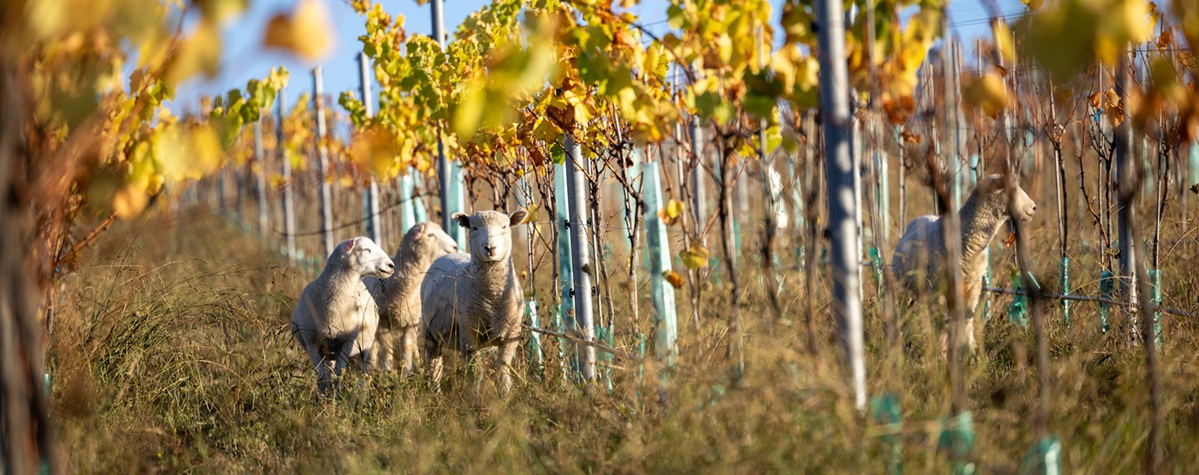










.png)








